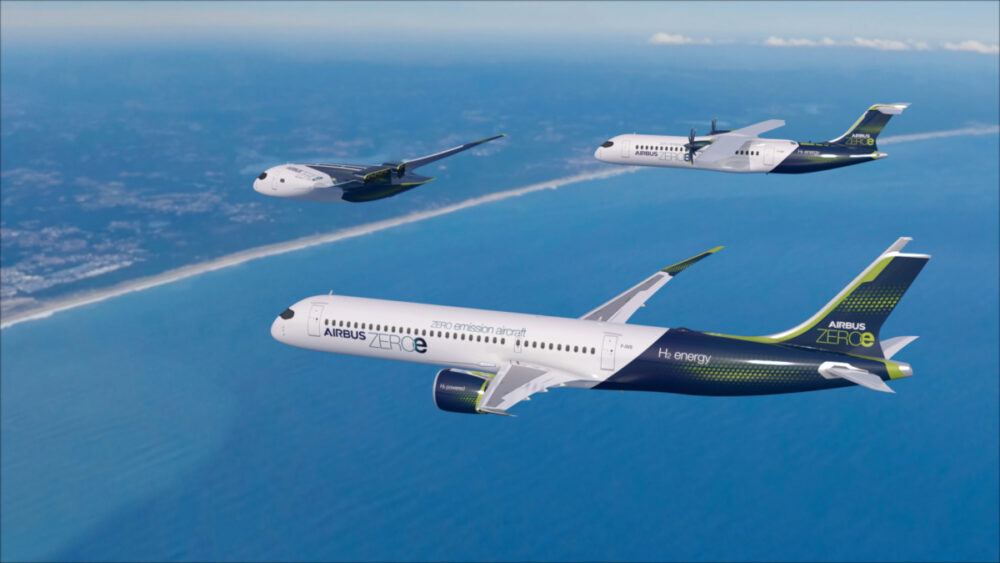It is being touted as a potential “holy grail” in the quest to decarbonize aviation. Hydrogen already successfully powers cars, so what does it take to transfer the technology to commercial flight? Let us take a look at how a hydrogen-fuelled passenger aircraft actually works.

Yesterday, the world’s first commercial-grade all-hydrogen-powered flight successfully took off, flew, and landed back down in Bedfordshire, UK. Along with Airbus’ ambitious zero-emissions concept release earlier this week, this makes it an excellent time to dive a little deeper into what goes on behind the fuselage of these aircraft.
In its simplest explanation, a hydrogen aircraft is an aircraft that uses hydrogen fuel as a power source instead of traditional jet fuel. It can either be burned in a jet engine or used to power a fuel cell that generates electricity. The hydrogen needs to be stored in special pressurized tanks inside the fuselage, as opposed to other fuel, which is stored in the wings.
No emissions but water
Long-touted as a viable option for a sustainable fuel source, hydrogen has recently risen to the forefront as one of the most probable contenders as commercial aviation grapples with lowering its contribution to global emissions. Planes using hydrogen as a power source would only emit water while traveling at near the same speed as aircraft with engines running on traditional jet-fuel.




Brief history of hydrogen flight
Of course, the basic technology is already available. In February 2008, Boeing flew the world’s first hydrogen-powered manned plane from an airfield near Madrid, Spain. The two-seat Dimona motor-glider was refitted with what is known as a proton exchange membrane. This fuel cell transforms the energy liberated during the chemical reaction of hydrogen and oxygen to electrical power.
In 2016, experimental four-seater HY4 took off from Stuttgart Airport in Germany. At the time, André Thess, head of the DLR Institute of Engineering Thermodynamics, said that the goal was to improve the fuel cell power train further and use it on regional aircraft with up to 19 passengers.




250 miles before the end of the year
ZeroAvia, the start-up responsible for yesterday’s six-seater Piper Malibu all-hydrogen feat, intends to fly ranges of 250 to 300 miles by the end of the year. Of course, there is also Airbus’ new concept, which could potentially enter service by 2035. This includes a regional turboprop, a medium-haul narrowbody option, and an innovative wide fuselage model.
Safe storage
Storage is undoubtedly one of the key components to take into consideration when designing hydrogen planes. Hydrogen needs to be stored in pressurized tanks. In Airbus’ medium-range turbofan design, for example, it would be stored and distributed via tanks located behind the rear-pressure bulkhead.
In general, hydrogen planes could be aesthetically similar to modern jetliners, albeit with a slightly elongated fuselage or shorter cabin. Meanwhile, a radically redesigned plane, such as Airbus’ 200-passenger “blended wing-body” design would open up more options for storing the gas.




Concerns related to the safety of storing hydrogen on an aircraft are often raised by those who question the technology. However, in an article in Sustainable Energy News from 1997, German scientists concluded that hydrogen aircraft would be no more dangerous than conventionally powered ones. In fact, in some respects, they could even be deemed safer. The researchers identified the main issue to lie with installing the necessary infrastructure at airports and refueling, rather than with the planes themselves.




Fuel cells vs. combustion
Then, of course, there are fuel cells needed to convert the hydrogen into energy. The technology already exists in hydrogen fuel-cell cars. Of course, hydrogen fueling stations are far and few between, so the broader introduction becomes somewhat of a chicken-and-the-egg situation.
The fuel cell is the system’s power plant. Hydrogen drawn from the onboard tanks is combined with oxygen. During the oxidation, hydrogen atoms react with oxygen atoms to form water. During this process, electrons are released. They then move through an external circuit as an electrical current. Water and heat are the only by-products.
This technology is incredibly quiet. Imagine those electric cars or mopeds you do not hear approaching. It would make for a very pleasant and noise-free plane-ride for passengers, not to mention the improved quality of life for those living in the near vicinity of an airport.
This is different from hydrogen-powered engines that use combustion. These are simply a modified version of a traditional internal combustion engine that uses conventional fuel sources. While the smaller aircraft taking flight thus far have used fuel cells, Airbus proposes installing combustion engines in its turboprop ZEROe.




R&I need to be accelerated
The Hydrogen Powered Aviation Report, released in May this year, concluded that “hydrogen propulsion has significant, so far underestimated potential to reduce the climate impact of aviation and contribute to decarbonization objectives.” However, it also adds that research and innovation must be immediately accelerated for the aviation industry to begin to make the transition.
The latest developments and presentations are undoubtedly exciting news. However, merely transitioning to hydrogen planes will not be a panacea for decarbonizing aviation. While zero-emission flights are a necessary goal and will contribute significantly to our transition towards a carbon-neutral society, unfortunately, most of today’s hydrogen is produced from methane, a natural gas. This process produces carbon dioxide in and of itself. The energy sector also has a lot of work to do.
What is your take on hydrogen planes? Do you think they should be redesigned to better accommodate storage options? Fuel cell or combustion engine? Let us know in the comments.



